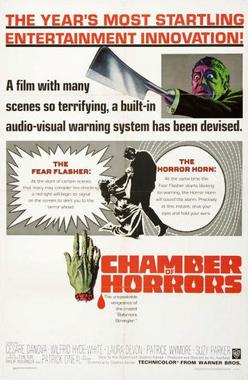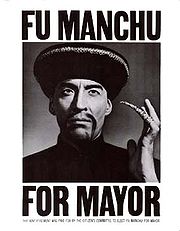
 |
|
|
|
For its latest Horror Double Feature Warners unleashes an amiable pair of thrillers that deliver the chills promised in their garish ads. Made in different countries, they have plenty of what was required to compete in the common market of 60s horror: sex, jeopardy, and a little gore. 1966's Chamber of Horrors began life as a TV pilot called "House of Wax" before being rerouted for theatrical use. New scenes emphasize bodily mutilation in low-life settings. Hy Averback's direction is split between fairly bland TV coverage and scenes designed with much more care and style. The show's concept -- a pair of good-humored wax museum proprietors help the Baltimore police solve grisly crimes -- seems like a blend of the semi-classic House of Wax and the TV favorite Maverick. Handsome Draco (Cesare Danova) has a female favorite in every bar, while the genial Harold Blount (Wilfrid Hyde-White) chats up an unbroken line of guest stars. Their dapper sidekick is Señor Pepe (Tun Tun, aka José René Ruiz) a gentlemanly dwarf. Action gags from the Vincent Price movie are recycled in the final chase, and Blount & Draco's wax museum marquee reads "House of Wax" as well. With its horror element toned down, Chamber of Horrors could easily fit into an hourly TV format. Stopping that idea cold is Jason Cravette, a sadistic maniac played in high style by Patrick O'Neal: before he cuts off one man's head and arms, Jason fills him in on the details, like a high-class waiter. Saucy Aunt Perryman (Jeanette Nolan) describes Jason as a bad boy, a real understatement. We first see Cravette forcing a minister to marry him to a corpse -- at gunpoint. To the sound of William Lava's enthusiastic score, Jason then arranges his bride's body on a wedding bed, like the infamous Horrible Dr. Hichcock. We learn later on that the "bride" wasn't raped, at least not when she was alive. Patrick O'Neal's stylish fling at horror stardom is much more successful than that of Jason Robards Jr., in American-International's unfocused and pretentious Murders in the Rue Morgue. 
Cravette is arrested in the act of playing "wedding" with a prostitute in Marie Windsor's brothel; his subsequent escape costs him his right hand. This cues the entrance of Chinese artisan Berry Kroeger, who fashions a hook for Jason that can be replaced with a meat cleaver, a scalpel and other Grand Guignol weapons. Jason prowls the streets in a black cape, enlisting prostitute Marie Champlain (Laura Devon) to help him trap and slaughter the lawmen responsible for his conviction. As Cravette's every bloody outrage becomes an exhibit for their wax museum, Draco and Blount profit from the very menace they strive to put behind bars. Their good humor earns Chamber of Horrors points as a class act, at least until the producers unveil their William Castle-like promotional gimmick. In a spooky prologue William Conrad explains the film's "escape valve": just before each of four ghastly sights, viewers will hear the "horror horn" and see the "fear flasher" to warn them to cover their eyes and turn away from the screen. It's a good gag, although it aims Chamber of Horrors directly at a juvenile audience. Also in the cast of notables are Wayne Rogers, soon to become Trapper John on the TV series M*A*S*H, model-turned actress Suzy Parker and Patrice Wymore. None other than Tony Curtis drops by for a "blink and you'll miss me" cameo. Something of a camp horror hybrid, Chamber of Horrors definitely has the right Guignol attitude. The Brides of Fu Manchu is the second in a series of Christopher Lee potboilers produced by Harry Allan Towers at the peak of his career. This was before Towers worked with Jesús Franco and began chasing around the world to Spain, Brazil and South Africa in search of local production bargains. Towers tapped into German production money for this vaguely 007-inspired thriller, which accounts for a cast split between English and German actors. Despite its fundamental racism Sax Rohmer's "Yellow Peril" character never waned in popularity, as demonstrated by the giddy, sadistic Pre-code Boris Karloff classic The Mask of Fu Manchu. Writing under the pen name Peter Welbeck, Towers' initial production The Face of Fu Manchu was a fairly exciting period adventure with plenty of fistfights and chases in old automobiles. The time frame appears to be the early 1920s. Christopher Lee is imposing in false eyelids and a long moustache. He'd donned similar makeup to play a gangster chieftain in Hammer's The Terror of the Tongs but his Fu Manchu is more of a Mabuse-like criminal arch-villain. Back at Fu's side is his cold-hearted daughter Lin Tang (Tsai Chin), an expert in disguises and an aficionado of refined tortures. 
The Brides of Fu Manchu sees Fu up to his old tricks, this time forcing famous scientists (Joseph Fürst, Rupert Davies) to perfect a "radio death ray" by kidnapping their daughters. Chinese bandits attack in broad daylight, snatching the women from hospitals or the banks of the Thames. Into the case comes Fu Manchu's Scotland Yard nemesis Sir Dennis Nayland Smith (Douglas Wilmer) and his assistant Dr. Petrie (Howard Marion Crawford), characters surely modeled on Doyle's Sherlock Holmes and Dr. Watson. They try to protect the beautiful Marie Lentz (Marie Versini) from Fu's henchmen; she finds out too late that her favorite beau happens to be Fu Manchu's Number One London operative. Returning for his second Ful/Lee outing, director Don Sharp (The Kiss of the Vampire) keeps the action humming. The radio weapon emanates from a hideout in the Atlas Mountains of Morocco and must be relayed to a receiver on a truck parked next to the target building; one wonders why a truck filled with explosives wouldn't produce the same effect. Nayland-Smith fails to prevent the sinking of an ocean liner by remote control, but tracks the radio signal to its African source. He joins the French Foreign Legion to ride to the rescue. The old cars are quaint and the action is relentless, even if Fu's knife-wielding henchmen prove to be no match for Marquis of Queensbury fisticuffs. The few effects utilized are on the weak side. Wrinkled canvas backdrops represent Fu's mountainous headquarters, where traveling mattes occasionally render human figures transparent. A second kidnapped daughter played by lovely Carole Gray (of The Curse of the Fly) becomes part of Fu Manchu's hypnotized harem of beauties held in his underground lair, the "Brides" of the title. The German release of Harry Allan Towers' film reportedly includes extra nudity and torture footage, which was never part of the version delivered to Warner Bros. Although Christopher Lee repeats his familiar curtain line, "The world will hear from me again!", Towers lost his Warner Bros. distribution deal after one more effort, 1967's The Vengeance of Fu Manchu. The producer made two more inferior Lee sequels directed with little style by Spaniard Jesús Franco. Both films in Warner Home Video's Horror Double Feature look splendid in colorful enhanced widescreen transfers. The flat 1.85 The Brides of Fu Manchu begins with a grainy and Ill-framed prologue because it repeats the conclusion of The Face of Fu Manchu, which was filmed in half-frame Techniscope. No extras or chapter selections are included, although the discs are encoded with chapter stops and removable subtitles in English and French. Curiously, three of the five Christopher Lee Fu Manchu movies are available in Region 1, but not Don Sharp's The Face of Fu Manchu, which remains the best of the lot.
On a scale of Excellent, Good, Fair, and Poor,
Reviews on the Savant main site have additional credits information and are often updated and annotated with reader input and graphics. Also, don't forget the 2008 Savant Wish List. T'was Ever Thus.
Review Staff | About DVD Talk | Newsletter Subscribe | Join DVD Talk Forum |
| ||||||||||||||||||